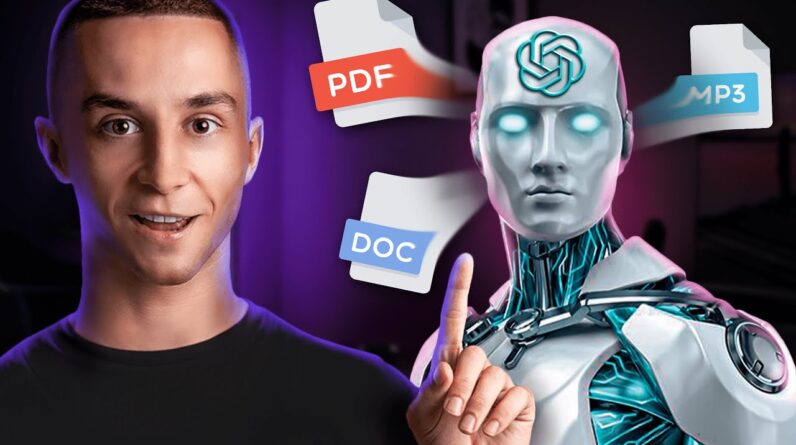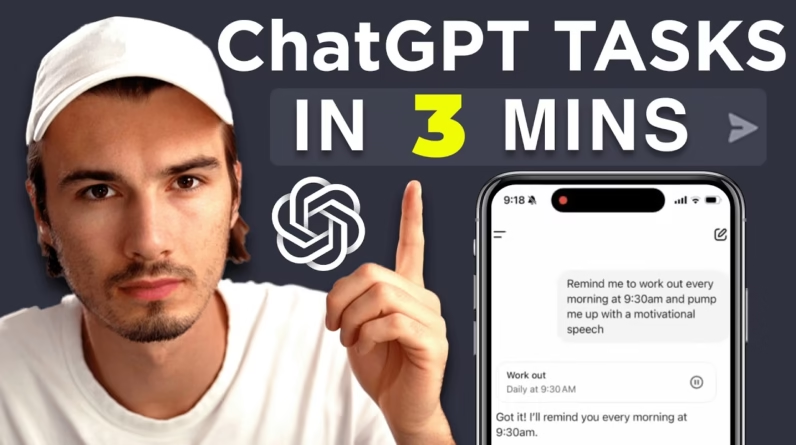
This article focuses on empowering you to train ChatGPT on your own data and communicate effectively via Slack. By creating a custom knowledge base chatbot that interacts with various document formats such as PDFs and YouTube transcripts, you’ll discover how to streamline your company’s productivity using AI tools like BerriAI. Step-by-step guidance will be provided on setting up this integration, from creating the knowledge base to configuring the Slack bot for seamless functionality.
You’ll learn how to use the BerriAI platform alongside Replit to host your chatbot and make it accessible through Slack. This approach not only enhances accessibility for your team but also ensures that essential information, like standard operating procedures and frequently asked questions, is just a chat message away. Whether you’re looking to simplify data retrieval or refine team communication, this guide will set you on the path to harnessing the power of AI in your daily operations.

Table of Contents
Understanding ChatGPT and Its Applications
Overview of ChatGPT
ChatGPT is an advanced AI language model that can engage in human-like conversations. Utilizing machine learning and vast datasets, it has been designed to understand and generate text-based responses according to user input. You can think of ChatGPT as a versatile assistant ready to answer questions, provide recommendations, or assist with various tasks. Its applications range from customer support to educational tools, enabling the extraction of valuable insights from vast amounts of data.
Benefits of Using ChatGPT for Businesses
Businesses can reap significant benefits by incorporating ChatGPT into their operations. First and foremost, it enhances productivity by automating customer support and other repetitive tasks, allowing your team to focus on more complex issues. The AI can provide instant responses, improving service quality and customer satisfaction. Additionally, ChatGPT can analyze and summarize large documents, helping you save time and streamline workflows. It also serves as a cost-effective solution, reducing the need for extensive human resources for handling inquiries.
Common Use Cases of ChatGPT in Companies
Incorporating ChatGPT into your business processes can lead to numerous use cases. For instance, many companies are utilizing it for customer service, where the chatbot can handle frequently asked questions and provide instant support. It’s also useful for training and onboarding, facilitating new employee integration by providing resourceful answers and guidance. Content generation is another arena where ChatGPT shines, producing creative ideas or drafting documents. Moreover, businesses are employing it for data analysis and reporting, allowing for quicker insights into customer behavior or market trends.
Getting Started with BerriAI
Introduction to BerriAI
BerriAI is a sophisticated tool designed to aid businesses in creating custom knowledge bases and chatbot applications. At its core, it makes it remarkably easy for you to upload documents or content and generate interactive chat interfaces that can respond intelligently to inquiries about the uploaded data. For those embarking on the journey of integrating AI into their workflow, BerriAI serves as an excellent starting point.
Key Features of BerriAI
One of the standout features of BerriAI is its user-friendly interface, which simplifies the process of building a chatbot. It supports various document formats, from PDFs to Word files, making any form of data easily accessible through chat. The tool also allows for customizing prompts, enabling the chatbot to respond in ways that are most relevant to your needs. Additionally, its integration capabilities with platforms like Slack mean that you can centralize information access and improve team collaboration.
How BerriAI Compares to Other Tools
When compared to other AI tools like LangChain and LlamaIndex, BerriAI holds a competitive edge due to its intuitive design and ease of use. While other tools might require extensive coding knowledge to set up, BerriAI streamlines the process, allowing you to focus on what matters: effective communication with your knowledge base. Moreover, its ability to connect with chat interfaces such as Slack provides an added convenience that is particularly beneficial for team collaboration.
Preparing Your Data for ChatGPT Training
Types of Data Suitable for Upload
When training ChatGPT or creating a custom knowledge base, it’s essential to choose the right type of data. You can upload various documents, including PDFs, spreadsheets, Word files, and even YouTube video transcripts. The key is to ensure that the content you choose is relevant to the queries you expect to receive, as this will help improve the accuracy of the responses generated by your chatbot.
Organizing Data for Optimal Performance
To ensure your chatbot performs optimally, organizing your data before uploading it is crucial. Start by categorizing documents into relevant groups based on common themes. Use clear naming conventions to make retrieval easier, and consider summarizing lengthy documents into key points. Proper organization not only enhances efficiency but also directly influences how well the ChatGPT can learn from your data and respond to user inquiries.
Creating Effective Prompts for Your Custom Knowledge Base
Prompts are vital for guiding ChatGPT’s responses based on your specific content. When creating prompts, be clear and precise to help the model understand the context and expected answers. For example, if you are training a financial assistant, your prompt might specify that the chatbot should answer questions about investments and market trends. Effective prompts define the scope of interaction and help tailor the chatbot’s behavior to better suit your needs.
Creating a Custom Knowledge Base
Step-by-Step Guide to Uploading Documents
Getting started with BerriAI involves simply uploading your documents. To do this, log into the BerriAI platform, navigate to the upload section, and select your chosen files. Ensure that your documents are in compatible formats, as this will facilitate smoother interactions with the chatbot. Once uploaded, you can proceed to define custom prompts that will frame how the AI interprets and responds to user queries.
Defining a Custom Prompt for Your Data
Once your documents are uploaded, it’s time to define a custom prompt tailored to your specific needs. Think about the main objectives for your chatbot—what kind of questions do you anticipate? Draft a prompt that outlines this clearly. For instance, if your chatbot is intended to assist with customer inquiries about products, the prompt could reflect that it should act as a knowledgeable product specialist.
Building and Testing the Knowledge Base Chatbot
After setting up your documents and defining your custom prompt, you can move on to building your chatbot. BerriAI will typically offer a straightforward interface to initiate this process. Once the chatbot is ready, it’s essential to test its functionality. Interact with the bot by asking various questions derived from your uploaded data, assessing its ability to provide relevant answers, and making any necessary adjustments to improve performance.
Forking and Customizing Code on Replit
How to Access Code on Replit
Replit is a collaborative coding environment that allows you to easily access and customize code for your chatbot. To get started, you’ll need to create a free Replit account. Once logged in, you can search for the project code related to ChatGPT and fork it—essentially creating your copy of the original code. This process allows you to modify the existing code for your specific requirements without the need to start from scratch.
Customizing the Code for Your Specific Needs
Once you have forked the code, you can dive into customizing it according to your preferences. This might include changing prompts, adjusting API keys associated with your BerriAI, or refining the logic that governs how the chatbot interacts within Slack. Be sure to pay attention to the settings that map out how the bot listens for messages and how it formulates responses based on the knowledge base you created earlier.
Best Practices for Forking Code
When forking code, there are several best practices to keep in mind. Always maintain a backup of your original code so you can revert to it in case of issues. Document any changes made to keep track of customizations and facilitate easier debugging. Moreover, ensure your code is readable by structuring your comments and variable names clearly. This practice not only aids in your understanding but also helps anyone else who might work with your code in the future.
Configuring Your Slack Bot
Creating a New Slack App
To harness the power of Slack for your new chatbot, the first step is creating a new Slack app. You can do this by accessing the Slack API page and selecting “Create New App.” You’ll be guided through a straightforward setup process, where you’ll provide an app name, select a workspace, and complete any necessary configurations.
Configuring Bot Token Scopes and Permissions
Once your app is created, it’s time to configure the permissions it will need to function effectively. You’ll navigate to the “OAuth & Permissions” section to define bot token scopes that dictate what your bot can do. For example, you may want to allow the bot to read messages, send replies, and access channel history. These permissions are critical, as they dictate the interaction capabilities of your Slack bot with users.
Retrieving and Using Slack Credentials
After properly setting up the permissions of your Slack app, you’ll need to retrieve the credentials necessary for your bot to function. This includes your Bot User OAuth Token and signing secret, which you must input in the Replit environment. Properly storing and utilizing these credentials is essential for your chatbot to authenticate effectively and communicate seamlessly within your Slack workspace.
Integrating BerriAI with Slack
Connecting the BerriAI API to Slack
With your Slack app and BerriAI environment set up, the next step is to integrate the two. Start by retrieving the API endpoint from BerriAI that you copied earlier. In Replit, you’ll need to set this endpoint in your code so the Slack bot can call your BerriAI chatbot for responses. This connection forms the backbone of your custom chatbot, enabling it to interact and provide information from your knowledge base.
Setting Up Event Subscriptions for Bot Interactions
To allow your Slack bot to engage with users effectively, you will need to set up event subscriptions. This entails configuring the bot to listen for specific events like messages in direct messages or channels. You can specify these events in the Slack app settings. By doing this, your bot will be equipped to respond to user inputs efficiently and streamline communication.
Testing the Integration for Functional Accuracy
After finalizing the integration between BerriAI and your Slack bot, it’s crucial to conduct thorough testing. Send various messages to your bot and analyze its responses based on the documents in your knowledge base. If any discrepancies occur, return to the code in Replit for adjustments. Testing ensures the functionality is accurate, providing users with the responses they need when they interact with the chatbot.
Validating the Chatbot Functionality
Methods to Test Chatbot Responses
When validating your chatbot’s functionality, consider a multi-faceted approach to ensure comprehensive testing. Engage in scenario-based testing by simulating various user inquiries relevant to your knowledge base. You can also include edge cases—questions that might be less common or purely speculative—to better assess the chatbot’s robustness. Collecting a diverse range of responses will help identify areas for further refinement.
Troubleshooting Common Issues
As with any technology, troubleshooting is a natural part of the process. Common issues might include the bot failing to recognize certain queries, providing unrelated responses, or being unable to access key information in your knowledge base. If you encounter such issues, review your custom prompts and the organization of your data. You may also need to revisit the connection settings between your Slack app and BerriAI API to rectify any misconfigurations.
Gathering Feedback for Improvement
Continual improvement is key to making your chatbot a valuable asset. Gather feedback from users to uncover their experiences, what functionalities they find useful, and which areas could use enhancements. This feedback can be instrumental in tailoring the chatbot experience to user expectations and ensuring that it remains a helpful tool for your team.
Exploring Use Cases for Custom Chatbots
Enhancing Team Productivity with Centralized Information
Custom chatbots can significantly enhance team productivity by serving as a centralized hub for information. Rather than sifting through various documents or seeking answers from colleagues, team members can simply pose questions to the chatbot. This streamlined approach not only saves time but also cultivates an environment of efficiency, where everyone has the information they need at their fingertips.
Extracting FAQs and SOPs with Ease
Another valuable application of chatbots lies in extracting FAQs and Standard Operating Procedures (SOPs). By consolidating essential documents into a knowledge base, you provide your team with a robust resource for addressing routine queries or clarifying procedures. This accessibility enables team members to focus on execution rather than searching for information, further driving productivity.
Real-World Examples of Successful Implementations
Various companies have successfully implemented custom chatbots to streamline their operations. For example, a financial services firm might utilize a chatbot to answer customer inquiries about investment options or account statuses, centralized in Slack for easy access. Similarly, a tech startup could deploy a chatbot for onboarding new employees by answering common questions regarding policies and procedures. Such applications highlight the adaptability and utility of chatbots in diverse business contexts.
Conclusion
Recap of Training ChatGPT on Your Data
In summary, using BerriAI to train ChatGPT on your specific data and integrate it within Slack can revolutionize how your team accesses and interacts with information. By following the outlined steps, you will empower your organization to leverage advanced AI while streamlining workflows and improving efficiency.
Encouragement to Explore Further
Don’t hesitate to explore the full potential of ChatGPT and BerriAI in your business context. Whether it’s improving customer service, onboarding new employees, or enhancing collaboration, the opportunities are vast and promising. Embrace this technology to stay ahead of the curve in an ever-evolving digital landscape.
Invitation for Collaboration and Consulting
If you’re interested in delving deeper into AI applications for your business or need assistance with implementation, feel free to reach out! Collaboration and consulting can open additional avenues for success and ensure that your AI integration aligns with your unique operational goals. Together, we can help usher in a new era of productivity through intelligent automation.







